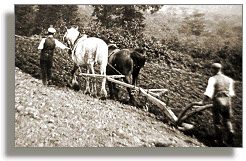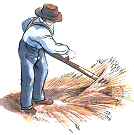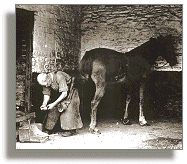the old way

Techniques for harvesting crops had remained virtually unchanged for hundreds of years until the Victorian age.
| Changes in farming methods |
Glossary
|
||
|
Before the 19th Century, fields were
ploughed using a team of horses or
of oxen. By Victorian times, steam engines
were being used on many farms for threshing and other work. |
|
|
Ploughing
the old way |
 |
As well as
being a far quicker way of working, steam ploughing
also meant that the horses previously used to pull the plough could be used
for other tasks. Techniques for harvesting crops had remained virtually unchanged for hundreds of years until the Victorian age. |
|
Using a Farrier |
The crop would  be cut with scythes and sickles, the
sheaves were tied up in bundles and left to dry, and then piled up to form
hay ricks or stored in barns. Women and children
would often be involved in this work.
be cut with scythes and sickles, the
sheaves were tied up in bundles and left to dry, and then piled up to form
hay ricks or stored in barns. Women and children
would often be involved in this work.In Victorian times, people working with sickles and scythes were gradually replaced by the horse-drawn reaper and the reaper-binder. |
 |
|
With the reaper-binder,
one man and two horses could do the same amount of work in one hour that
a scytheman could manage in a whole day. In the farm barns, corn would
ripen and be threshed. Before the 19th Century, threshing
was done by hand by a team of people. In Victorian times, again farming
methods changed to speed up the process, and machines
began to carry out the work of threshing. More about old ways and implements...
|
|
||
|
RDR
|